Definition of Performance Management
- Performance management acts as a continuous process.
- Determines performance and aligns it with organizational goals.
- Identifies, gauges, and develops overall organizational performance.
- Maintains good communication between employees and supervisors.
- Communication entails setting goals, feedback, and reviews results.
- The process occurs throughout the year (Aguinis, 2013).
- Process entails end-to-end supervision of organizational performance.
Performance management is defined as an ongoing procedure that focuses on pinpointing, gauging, and developing the performance within organizations while aligning it with the anticipated objectives. The process also entails maintaining excellent communication between workers and supervisors to attain the projected goals efficiently. Performance management occurs throughout the year and concentrates on setting goals, observing performance, offering feedback, and appraising results (Aguinis, 2013). Consequently, performance management involves providing end-to-end supervision of individual and team performance.

Aligning Performance Management with an Organization’s Strategy
- Performance management aligns with the organization’s strategy.
- Employees’ activities should match the organization’s goals.
- The alignment maintains efficiency and competitive advantage (Aguinis, 2013).
- Alignment entails setting targets reflecting organization’s strategy.
- The targets should be feasible.
- The goals must be communicated effectively.
- Goals should be reviewed and monitored frequently.
Aligning performance management with organizational strategy entails matching the employees’ activities and performance with the organization’s approach to achieve the anticipated objectives and increase the competitive strength. The alignment also involves entails setting targets that fully reflect the organization’s strategy. The targets should be feasible to ensure that they are easily achieved. Additionally, the goals should be communicated effectively to all employees to avoid unnecessary confusion (Aguinis, 2013). Lastly, the targets must be appraised and monitored regularly to identify the overall progress and areas that need improvement.
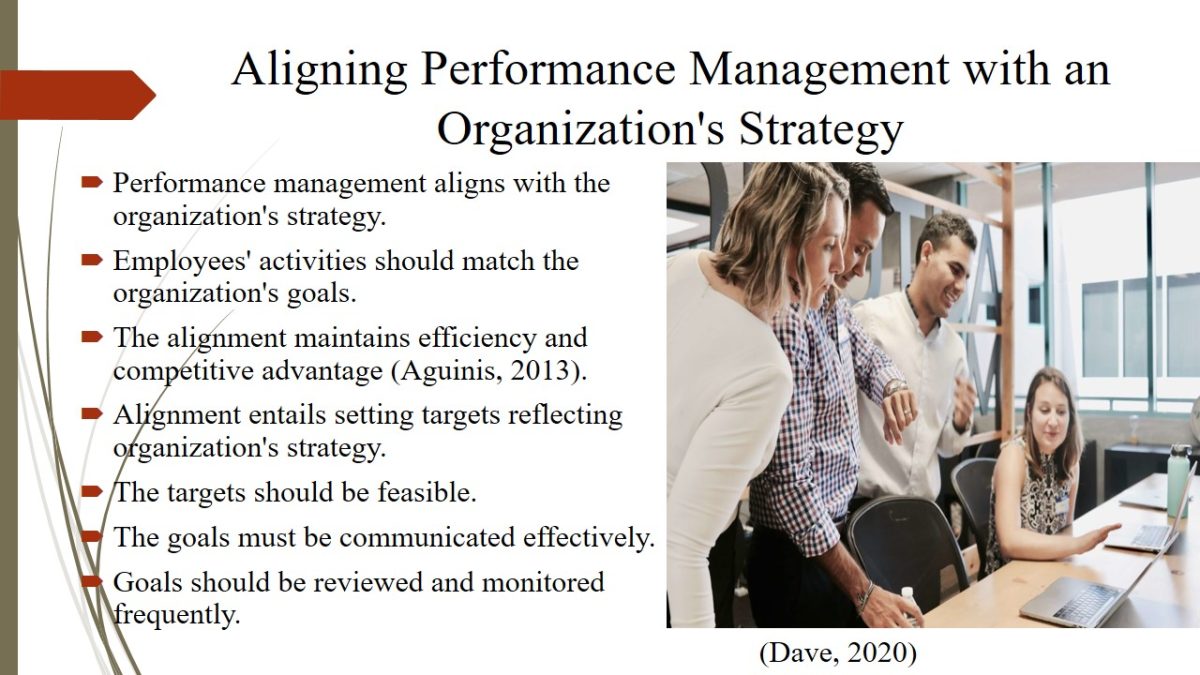
Benefits of the System
- Performance management has several benefits.
- One of the benefits is increased motivation.
- Employees remain highly motivated to improve performance.
- Secondly, performance management augments self-esteem.
- Continuous feedback fulfills needs and increases recognition (Aguinis, 2013).
- Thirdly, the system makes organizational goals clear.
- Employees fully comprehend organization’s needs and strategies.
- Fourthly, the system upsurges employee competency.
- Organizations improve performance through employee training.
- Improved competence increases employee satisfaction.
- Fifthly, the system reduces misconduct (Aguinis, 2013).
- Understanding an organization’s strategy encourages ethical practices.
- Lastly, performance management prevents unnecessary lawsuits.
- The system maintains compliance with regulations.
Performance management has numerous benefits to organizations, which create its high demand. One of the benefits of a performance management system is that it increases employees’ motivation as they understand their performance and areas that need improvement. Secondly, the system enhances self-esteem due to continuous feedback regarding their performance, allowing the employees to feel valued and recognized (Aguinis, 2013). Thirdly, performance management ensures that organizational goals are clear, thus making it easy for all organizational members to understand the set objectives and attain them.
Performance management systems increase employees’ competence as organizations focus on improving performance through continuous training. The training allows employees to acquire new skills and knowledge, enabling them to seamlessly accomplish their tasks, thus increasing their satisfaction. Additionally, the system minimizes misconduct as individuals comprehend the organization’s culture and goals, thus encouraging ethical practices (Aguinis, 2013). Lastly, the system averts needless lawsuits that adversely affect the organizational reputation and financial position.
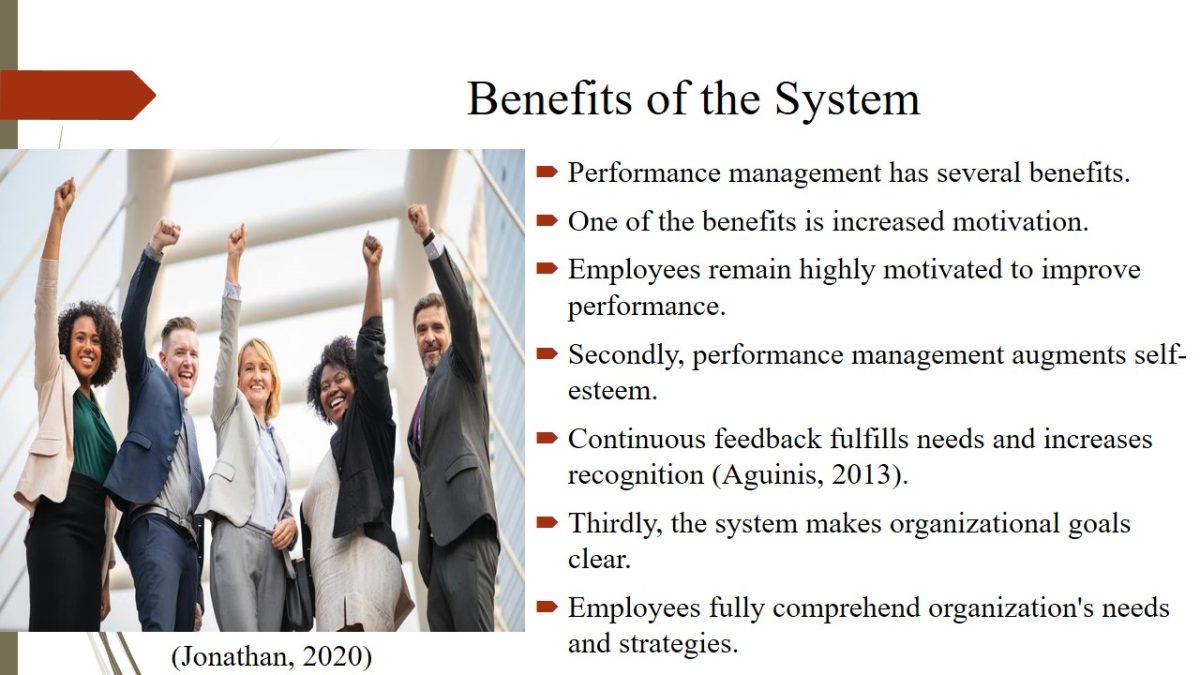

Implementing Performance Management
- Implementing the system involves several players.
- Organizational support and acceptance are crucial.
- Developing communication plan before implementation is essential.
- Proper communication prevents resistance and improves satisfaction.
- Communication plan is followed by appeals process.
- Employees ask administrative and judgmental questions (Aguinis, 2013).
- The process resolves potential disagreements.
- Implementation entails training to pass needed skills.
- Training allows individuals understand need for the system.
- The training is followed by pilot testing (Aguinis, 2013).
- The testing encourages revisions and adjustments.
- This creates room for attaining efficiency.
- The implementation entails continuous evaluation and monitoring.
- Evaluation and monitoring reveal the system’s impacts.
Implementing performance management usually involves several players to achieve smooth flow of activities. Consequently, the system must obtain acceptance and support from all organizational members. Before implementing the system, a communication plan is developed to ensure that all individuals understand the organization’s anticipations to prevent unnecessary resistance and increase satisfaction. The appeals process is adopted to obtain complete employee acceptance. The process allows employees to ask administrative and judgmental questions to understand the system (Aguinis, 2013). The appeal process further aids in resolving disagreements related to performance management.
The training programs within the implementation allow the employees to attain the needed skills and tools to improve their motivation and permit easy system’s implementation. The training enables individuals to comprehend the need and impact of the system. Additionally, the implementation entails the need for pilot testing, which creates an opportunity to revise and adjust the system (Aguinis, 2013). This enhances efficiency as the possible difficulties are identified in advance. Lastly, the implementation entails continuous evaluation and monitoring to reveal the impact of the system and aid in making proper future decisions.
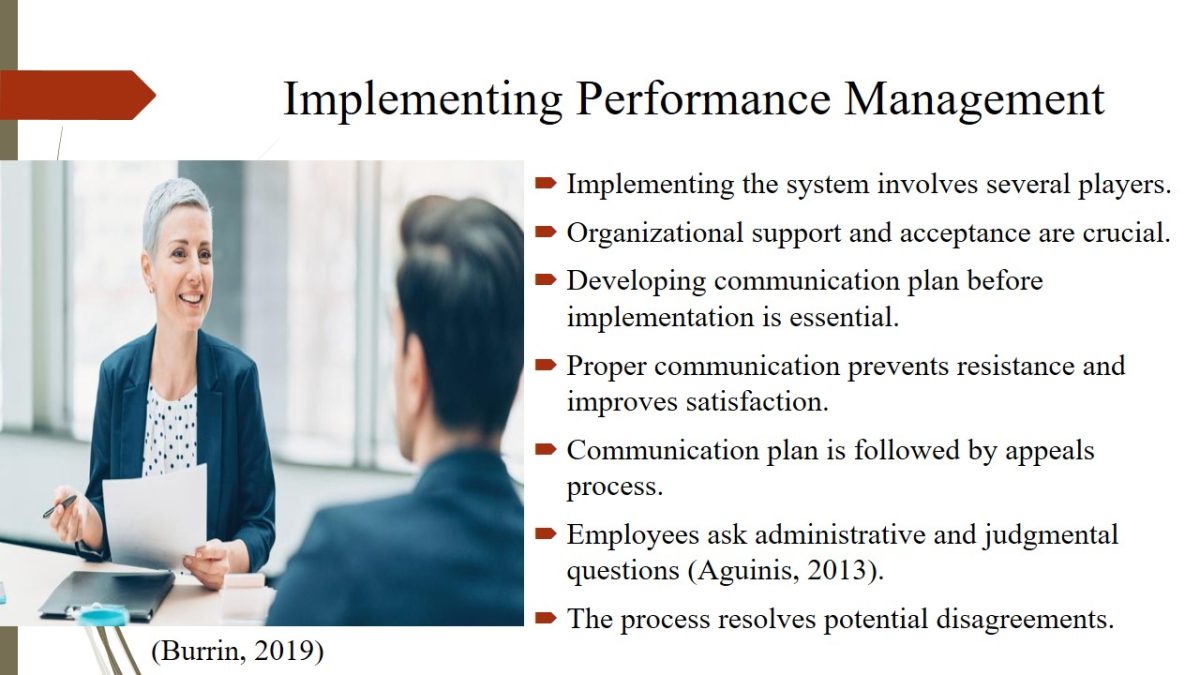
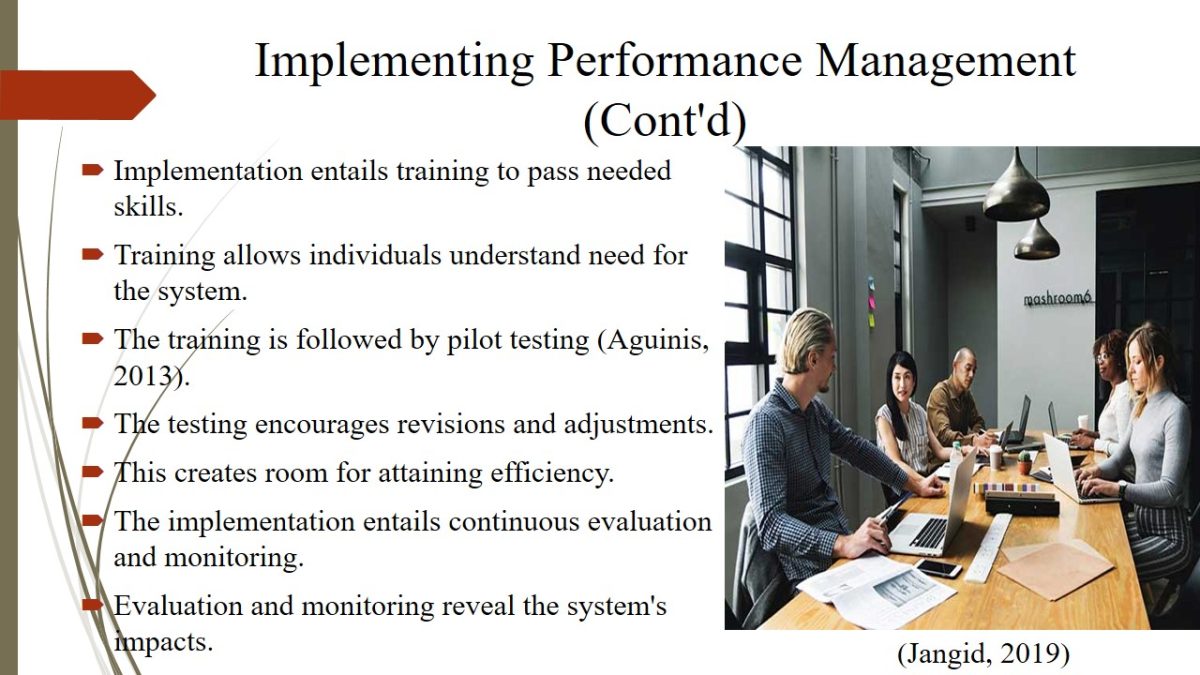
Evaluating Performance Management
- Evaluation determines whether anticipated impacts are achieved.
- The evaluation focuses on the system’s participants.
- The process may entail a confidential survey.
- The survey assesses the supervisor’s actions.
- The survey assesses the system’s perceptions.
- The evaluation determines the return on investment (Aguinis, 2013).
- ROI assesses the system’s overall impact.
Evaluating the performance management system is essential as it allows organizations to determine whether the projected impacts have been achieved. The evaluation focuses on the individuals who participated in the system to obtain their feedback. The evaluation process may entail adopting a confidential survey to determine how the supervisors have helped enhance the system’s success (Aguinis, 2013). The survey further determines the perceptions of the ratees and raters of the system. Additionally, the evaluation of the performance management system uses return on investment (ROI) to assess the impact of the system.
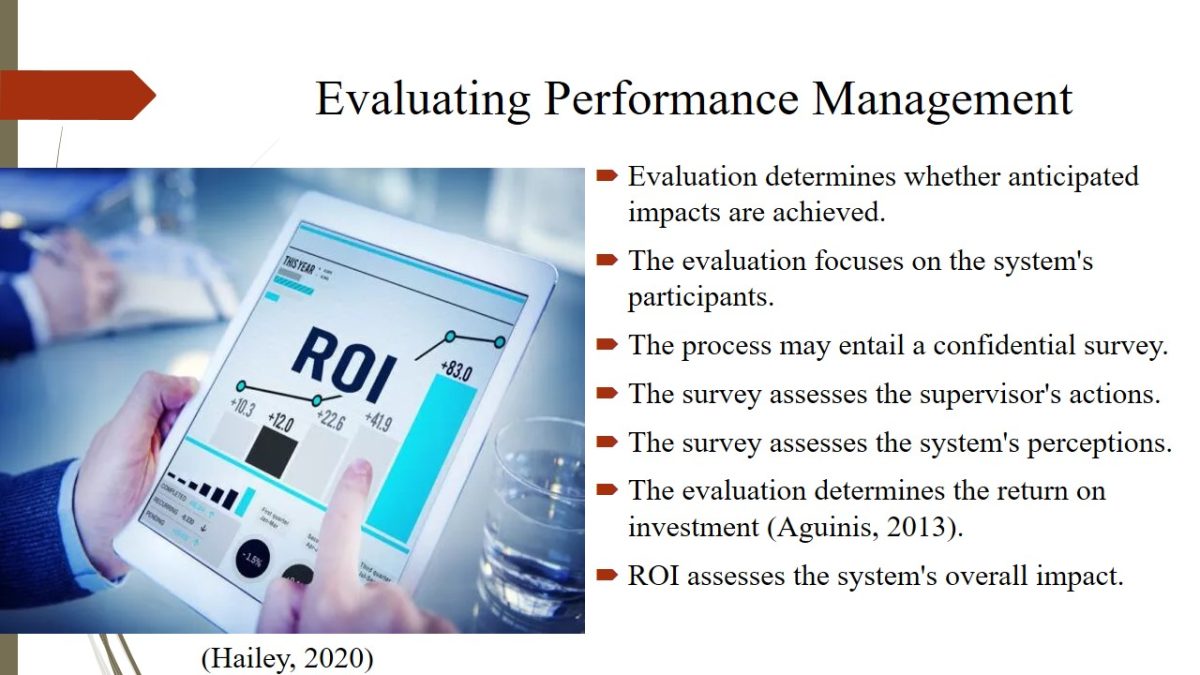
Roles and Responsibilities of Management
- The management plays various roles and responsibilities.
- The management designs the right policies.
- The policies aid in maintaining the system’s efficiency.
- The management reveals the organization’s core values (Aguinis, 2013).
- Managers convince other individuals of system’s importance.
- Management discloses work expectations and maintains communication.
- Lastly, the management provides leadership.
One of the critical roles and responsibilities is to design policies that ensure that the system remains efficient and achieves the desired goals. The management discloses the organization’s core values and culture to demonstrate the projected goals and strategies. The managers convince other individuals of the system’s benefits while maintaining good communication across the organization and defining work expectations to attain success (Aguinis, 2013). Lastly, the management provides leadership to all individuals by acting as role models to improve organizational performance.
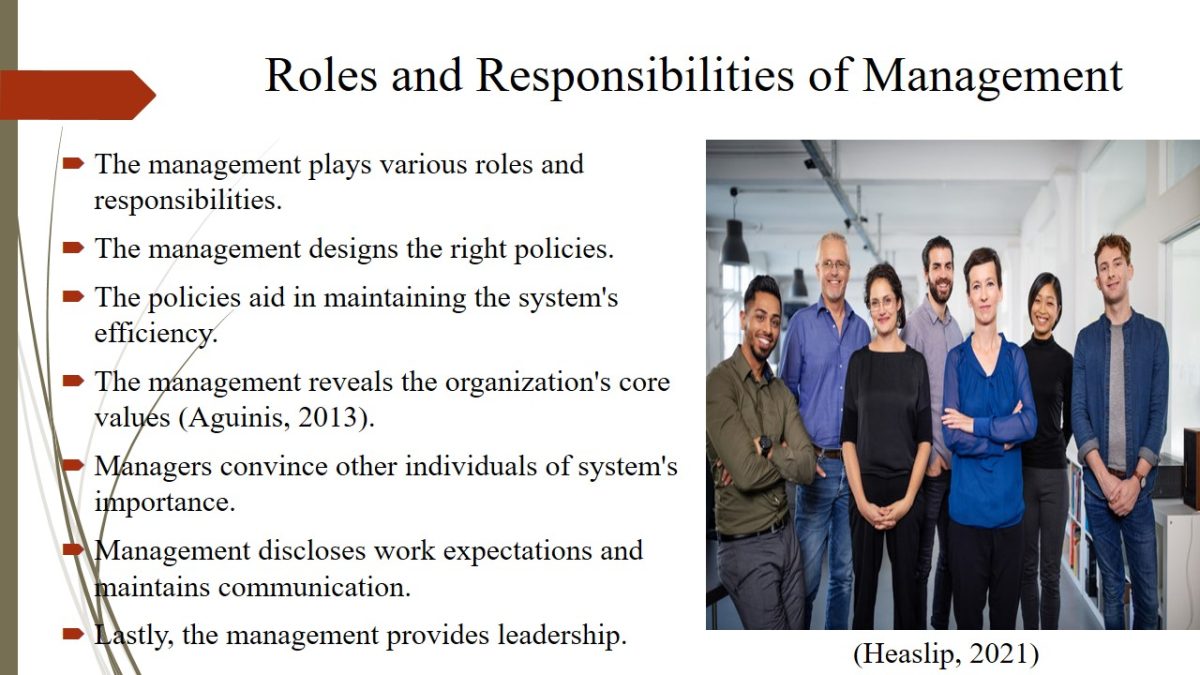
References
Aguinis, H. (2013). Performance management (3rd ed.). Pearson.
Burrin, P. (2019). Performance management: Time to ditch the annual appraisal. HRZone. Web.
Dave, E. (2020). Best practices for modern performance management. Trakstar. Web.
Hailey, G. (2020). Different ways to calculate ROI. Joshua Lyons Marketing. Web.
Heaslip, E. (2021). How to structure your management team. Web.
Jangid, S. (2019). 10 strategies for effective performance management. Big Data Made Simple. Web.
Jonathan, F. (2020). 12 proven ways to keep your employees motivated & happy [2020 updated]. TalenX. Web.
Mosley, E. (2020). 6 ways to reinvent your company’s performance management. Forbes. Web.
Stange, J. (2020). The who, what, why, and how of performance management. Employee Success Software | Quantum Workplace. Web.